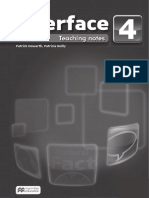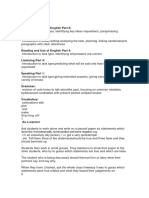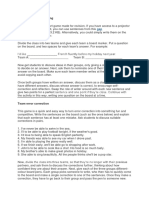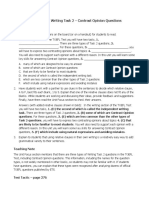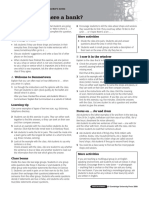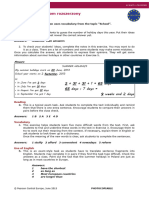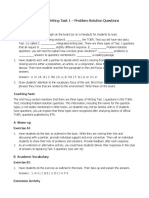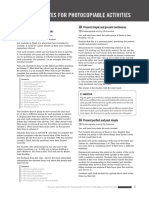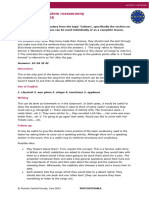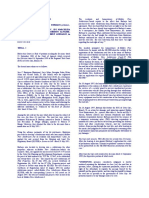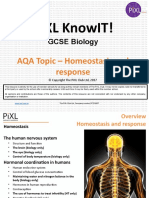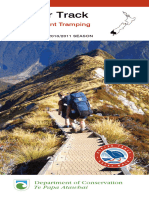GP Teachers April 2013
GP Teachers April 2013
Uploaded by
agnieszkaludwikaemerieCopyright:
Available Formats
GP Teachers April 2013
GP Teachers April 2013
Uploaded by
agnieszkaludwikaemerieOriginal Title
Copyright
Available Formats
Share this document
Did you find this document useful?
Is this content inappropriate?
Copyright:
Available Formats
GP Teachers April 2013
GP Teachers April 2013
Uploaded by
agnieszkaludwikaemerieCopyright:
Available Formats
Gimnazjum – Poziom podstawowy
TEACHER’S NOTES
This lesson uses vocabulary from the topic “Travelling and tourism”.
Warm-up
1. Ask students to read and complete the questions. If necessary, point out that all the
missing words are related to travelling and holidays and/or that all the missing letters
are vowels. Check the answers as a class.
Answers: A seaside B mountain C countryside D city centre E campsite
Extra idea
When you have checked the answers, make sure that students understand the questions.
Encourage students to ask and answer the questions in pairs. Ask a few students to report
their partner's answers.
Reading
2. This is a typical exam task. The aim of this exercise is to check that students can
identify where these signs and notices can be seen or identify their authors' intentions.
If your students find it difficult to do, help them by asking:
1. What kind of information do you normally see on a shop door?
2. What is public transport? How many means of transport can you name?
3. What kind of information can you get in a tourist information office?
Answers: 1C 2A 3E 4B
Use of English
3. Ask students to look at the three photos and try to describe them, giving as many
details as possible. Then, ask students to read the postcard, ignoring the gaps at this
stage. Explain to the class that their task is to choose the photo which shows what Sally
likes about her trip to France.
Answers: A (food market)
4. This is a typical exam task, as students have to complete a short text using
three of the given words. Remind them of the fact that there are six words but only
three of them are needed. Ask students to work individually, read the postcard again
and complete it. Let them compare their answers in pairs before checking them as a
class.
Answers: 1 raining 2 noisy 3 lots
Functions
5. This is another typical exam task. Students read the context given in Polish and choose
the best reaction in each situation. You may ask them to explain (in Polish) why the
other options are incorrect.
Answers: 1B 2A 3B
Speaking
6. Working in pairs, students take turns to ask and answer these questions. If you have
some spare time at the end of the lesson, you can ask students to do this task twice,
working with different partners each time.
Answers: Students' own answers
© Pearson Central Europe, April 2013 PHOTOCOPIABLE
You might also like
- Lesson Plan For English Grade V Using Explicit InstructionDocument3 pagesLesson Plan For English Grade V Using Explicit InstructionBea DeLuis de Tomas89% (131)
- The Art Science and Technology of Pharmaceutical Compounding 5nbsped 1582122636 9781582122632 CompressDocument740 pagesThe Art Science and Technology of Pharmaceutical Compounding 5nbsped 1582122636 9781582122632 CompressFlorin Apotrosoaei100% (1)
- Persuasion GamesDocument192 pagesPersuasion GamesJared LimNo ratings yet
- Teachers Book Key To Bachillerato 1Document15 pagesTeachers Book Key To Bachillerato 1Jose Miguel Perez32% (44)
- 1877 The Three Worlds PDFDocument197 pages1877 The Three Worlds PDFjesusishorusNo ratings yet
- Inteface 4 Teachers BookDocument215 pagesInteface 4 Teachers BookGabriela Kopeć75% (4)
- FCE Gold Photocopiable MaterialDocument58 pagesFCE Gold Photocopiable MaterialDamián Gallagher100% (2)
- Cambridge English Starters Official TestDocument4 pagesCambridge English Starters Official Testmiren48No ratings yet
- Answer Key Lesson 1Document7 pagesAnswer Key Lesson 1aliciamarribNo ratings yet
- An Overview of The Rabbit Industry in The PhilippinesDocument3 pagesAn Overview of The Rabbit Industry in The Philippinesallan variasNo ratings yet
- b1 Holiday Accommodation TNDocument3 pagesb1 Holiday Accommodation TNMaria GeltzNo ratings yet
- Straight To First TB TravelDocument7 pagesStraight To First TB TravelLucrecia100% (1)
- GR Teachers April 2013Document2 pagesGR Teachers April 2013agnieszkaludwikaemerieNo ratings yet
- Bi Grade 3 - Lesson PlanDocument16 pagesBi Grade 3 - Lesson PlanMeEn VirgoNo ratings yet
- BkengselDocument112 pagesBkengsela_2014No ratings yet
- Describing Pictures and People TeacherDocument36 pagesDescribing Pictures and People TeacherAve CaesarNo ratings yet
- Alcohol: Teacher's Notes and Tips - Elementary: Tip: Personalize The TopicDocument2 pagesAlcohol: Teacher's Notes and Tips - Elementary: Tip: Personalize The TopicUbavka IsijanovskaNo ratings yet
- Taufik Sulaiman - Bahasa InggrisDocument8 pagesTaufik Sulaiman - Bahasa InggrisZartahum ZarNo ratings yet
- Voices Elementary Unit 1 Worksheets Notes and Answer KeyDocument2 pagesVoices Elementary Unit 1 Worksheets Notes and Answer Keycarlos.fajardoNo ratings yet
- E3 - Week 3Document12 pagesE3 - Week 3phuongthaotran.110496No ratings yet
- Team Gap Fill For RevisingDocument3 pagesTeam Gap Fill For RevisingSoner YaşarNo ratings yet
- Formative Assessment Strategies On A RingDocument4 pagesFormative Assessment Strategies On A Ringapi-273804717No ratings yet
- Traveling SoloDocument2 pagesTraveling SoloAshley NealNo ratings yet
- Alcohol: Teacher's Notes and Tips - Pre-Intermediate: Fruit Juice or Soda E.G. Coke or Tonic WaterDocument2 pagesAlcohol: Teacher's Notes and Tips - Pre-Intermediate: Fruit Juice or Soda E.G. Coke or Tonic WaterAreli CollaoNo ratings yet
- Sri Ratna Kumala - Modul Bahasa Inggris (Adiwiyata)Document10 pagesSri Ratna Kumala - Modul Bahasa Inggris (Adiwiyata)Zartahum ZarNo ratings yet
- Mega Goal 2 (1 To 5) PreprationDocument69 pagesMega Goal 2 (1 To 5) PreprationPuthiput Chotsutaworakul100% (1)
- GP Teachers June 2013Document2 pagesGP Teachers June 2013agnieszkaludwikaemerieNo ratings yet
- Unit 8 Listening - Gist-Content Questions and Gist-Purpose QuestionsDocument7 pagesUnit 8 Listening - Gist-Content Questions and Gist-Purpose QuestionsIman ShahrvandnegarNo ratings yet
- French 3 - Contemporary Life UnitDocument4 pagesFrench 3 - Contemporary Life Unitjlsigman4No ratings yet
- Teaching Notes - Unit 26 PDFDocument10 pagesTeaching Notes - Unit 26 PDFIman ShahrvandnegarNo ratings yet
- 1Document60 pages1MajddiNo ratings yet
- Be b1 Teaching Guide PDFDocument19 pagesBe b1 Teaching Guide PDFBence ZarándiNo ratings yet
- Untuktugas AssesmentDocument18 pagesUntuktugas AssesmentQueensya QaireenNo ratings yet
- Ket Reading Writing Part 1Document6 pagesKet Reading Writing Part 1Lucio Cipresso0% (1)
- Inspired 7 2Document9 pagesInspired 7 2Гулсун АбдрахмановаNo ratings yet
- (GR) CHECK - Textbook Answers Section 3 (Hodder & Stoughton)Document73 pages(GR) CHECK - Textbook Answers Section 3 (Hodder & Stoughton)Isabelle MadlomNo ratings yet
- First Certificate WorkshopDocument50 pagesFirst Certificate WorkshopbillybatsNo ratings yet
- Inspired 7 1Document10 pagesInspired 7 1Гулсун АбдрахмановаNo ratings yet
- A2 Free Time ActivitiesDocument4 pagesA2 Free Time Activitiescami pecovichNo ratings yet
- Voices Intermediate Unit 5 Worksheets Notes and Answer Key 0 PDFDocument3 pagesVoices Intermediate Unit 5 Worksheets Notes and Answer Key 0 PDFLo-Lo SanguineNo ratings yet
- 7gold HomeworkDocument8 pages7gold Homeworkafnadyebqjzazl100% (1)
- Teacher - S Guide 5.1Document5 pagesTeacher - S Guide 5.1Erick LandaburuNo ratings yet
- EnglishSkills L2 PED ReadingTNDocument16 pagesEnglishSkills L2 PED ReadingTNnguyenletam1995No ratings yet
- Tiered and Biased TasksDocument5 pagesTiered and Biased Tasksterranostra76No ratings yet
- GR Teachers June 2013Document2 pagesGR Teachers June 2013agnieszkaludwikaemerieNo ratings yet
- ESOL Absolute Beginners - Unit 6 PDFDocument18 pagesESOL Absolute Beginners - Unit 6 PDFAideen O'Sullivan100% (1)
- ? To Improve WritingDocument5 pages? To Improve WritingReda AlsadekNo ratings yet
- TKT Macmillan ResourcesDocument12 pagesTKT Macmillan Resourcesnanina2014No ratings yet
- If Clause Type 1Document4 pagesIf Clause Type 1Romaric DambreNo ratings yet
- ESOL Absolute Beginners Unit 4 No RomanDocument9 pagesESOL Absolute Beginners Unit 4 No RomanAideen O'SullivanNo ratings yet
- Unit 22 Writing - Integrated Writing Task 1 - Problem-Solution QuestionsDocument7 pagesUnit 22 Writing - Integrated Writing Task 1 - Problem-Solution QuestionsIman ShahrvandnegarNo ratings yet
- LP English 3Document4 pagesLP English 3chechebasister6No ratings yet
- Empower Intermediate Photocopiable - Teacher NotesDocument21 pagesEmpower Intermediate Photocopiable - Teacher NotesAmira BentebbalNo ratings yet
- 3 Func Lang Prac People in PhotosDocument2 pages3 Func Lang Prac People in Photosfexogav441No ratings yet
- DEMO LESSON On UNIT 5Document6 pagesDEMO LESSON On UNIT 5Тунук ПазиловаNo ratings yet
- French Speaking Activities (KS3): Fun Ways to Get KS3 Pupils to Talk to Each Other in FrenchFrom EverandFrench Speaking Activities (KS3): Fun Ways to Get KS3 Pupils to Talk to Each Other in FrenchRating: 5 out of 5 stars5/5 (2)
- How To Write Reading And Listening ActivitiesFrom EverandHow To Write Reading And Listening ActivitiesRating: 5 out of 5 stars5/5 (2)
- Fun Learning Activities for Modern Foreign Languages: A Complete Toolkit for Ensuring Engagement, Progress and AchievementFrom EverandFun Learning Activities for Modern Foreign Languages: A Complete Toolkit for Ensuring Engagement, Progress and AchievementNo ratings yet
- All of the Above: Essays on Teaching English as a Foreign LanguageFrom EverandAll of the Above: Essays on Teaching English as a Foreign LanguageNo ratings yet
- January 2010 Lowersecondary StudentsDocument6 pagesJanuary 2010 Lowersecondary StudentsagnieszkaludwikaemerieNo ratings yet
- May 2011 Lowersecondary StudentsDocument3 pagesMay 2011 Lowersecondary StudentsagnieszkaludwikaemerieNo ratings yet
- October 2011 Lowersecondary TeachersDocument2 pagesOctober 2011 Lowersecondary TeachersagnieszkaludwikaemerieNo ratings yet
- GP Students DecemberDocument2 pagesGP Students DecemberagnieszkaludwikaemerieNo ratings yet
- GR Teachers JuneDocument2 pagesGR Teachers JuneagnieszkaludwikaemerieNo ratings yet
- Leap Years Notes 12 15Document3 pagesLeap Years Notes 12 15agnieszkaludwikaemerieNo ratings yet
- Mission FCE 1 CompanionDocument134 pagesMission FCE 1 CompanionagnieszkaludwikaemerieNo ratings yet
- Photocopiable ResourcesDocument14 pagesPhotocopiable ResourcesagnieszkaludwikaemerieNo ratings yet
- GR Students Feb 2013Document2 pagesGR Students Feb 2013agnieszkaludwikaemerieNo ratings yet
- GP Teachers June 2013Document2 pagesGP Teachers June 2013agnieszkaludwikaemerieNo ratings yet
- Clothes, Holidays, Wild Animals FlashcardsDocument29 pagesClothes, Holidays, Wild Animals FlashcardsagnieszkaludwikaemerieNo ratings yet
- Unit 1 High Note 3Document3 pagesUnit 1 High Note 3agnieszkaludwikaemerie100% (1)
- Christmas WorksheetsDocument6 pagesChristmas WorksheetsagnieszkaludwikaemerieNo ratings yet
- Uczeń Srodki Jezykowe Matura Rozszerzona1Document18 pagesUczeń Srodki Jezykowe Matura Rozszerzona1agnieszkaludwikaemerieNo ratings yet
- PTP 1588 PDFDocument6 pagesPTP 1588 PDFMicheal Kyaw ZinNo ratings yet
- Writing Skills Are An Important Part of CommunicationDocument10 pagesWriting Skills Are An Important Part of CommunicationHarshitaSinghNo ratings yet
- Fresher Juice Activation PlanDocument14 pagesFresher Juice Activation PlanMalik Muhammad SufyanNo ratings yet
- De Moor Joost What Moment For Climate Activism?Document10 pagesDe Moor Joost What Moment For Climate Activism?Consuelo BiskupovicNo ratings yet
- Progress Report: Design Considerations of Go KartDocument6 pagesProgress Report: Design Considerations of Go KartINNOVIZ 19No ratings yet
- Technical Commu ReportDocument18 pagesTechnical Commu Reportali_sabriNo ratings yet
- EST Brochure JordanDocument2 pagesEST Brochure JordanMahmood ShanaahNo ratings yet
- Modul 6 Full Disclosure in Financial Reporting2 PDFDocument42 pagesModul 6 Full Disclosure in Financial Reporting2 PDFBenjamin Engel100% (1)
- Inside The Perimeter: Six Steps To Improve Your Security MonitoringDocument43 pagesInside The Perimeter: Six Steps To Improve Your Security MonitoringjeffgrantinctNo ratings yet
- An Analysis of Trends and Sales in The Video Game Industry: Business Analytics ProjectDocument10 pagesAn Analysis of Trends and Sales in The Video Game Industry: Business Analytics ProjectNavpreet HansNo ratings yet
- Property - Page 6Document54 pagesProperty - Page 6Anisah AquilaNo ratings yet
- Pixl Knowit!: Gcse BiologyDocument85 pagesPixl Knowit!: Gcse BiologyKausar AhmedNo ratings yet
- (Performance Philosophy) Broderick Chow, Alex Mangold (Eds.) - Žižek and Performance (2014, Palgrave Macmillan UK) PDFDocument283 pages(Performance Philosophy) Broderick Chow, Alex Mangold (Eds.) - Žižek and Performance (2014, Palgrave Macmillan UK) PDFMaria Santolo100% (1)
- Java 5 CH 11 MCAnswersDocument13 pagesJava 5 CH 11 MCAnswersAbigael HNo ratings yet
- TT LimitedDocument23 pagesTT Limitedpuneet.glennNo ratings yet
- Kepler-Track-BrochureDocument25 pagesKepler-Track-Brochurepaulova.danielaNo ratings yet
- Evaluation Rubric For Educational Games Laura St-MathDocument5 pagesEvaluation Rubric For Educational Games Laura St-Mathapi-233963987No ratings yet
- Press Release: Lexington Police DepartmentDocument1 pagePress Release: Lexington Police Departmentapi-239704480No ratings yet
- BOOK David Miller - Measurement by The Physical Educator - Why and How (2010, McGraw-Hill Education) - Libgen - lc-111-117Document7 pagesBOOK David Miller - Measurement by The Physical Educator - Why and How (2010, McGraw-Hill Education) - Libgen - lc-111-117R DarmawanNo ratings yet
- Conversation IxDocument10 pagesConversation IxWau BijakNo ratings yet
- Akintunde Akinyemi - The Yoruba Royal Birds Their Work and Relevance in The Society PDFDocument17 pagesAkintunde Akinyemi - The Yoruba Royal Birds Their Work and Relevance in The Society PDFAngel SánchezNo ratings yet
- Economic Nationalism (DoW) (Self)Document7 pagesEconomic Nationalism (DoW) (Self)Shaurya JeetNo ratings yet
- Basic 9 Basic Tech 3RD Term E-NotesDocument17 pagesBasic 9 Basic Tech 3RD Term E-NotesAkinyemi Odunayo100% (1)
- 23UHV02-UHV SYLLABUS AND NOTESDocument77 pages23UHV02-UHV SYLLABUS AND NOTESmanjunadhasompalleNo ratings yet
- Paper Title: 2.2 Final StageDocument4 pagesPaper Title: 2.2 Final StageDanica PirslNo ratings yet
- The Victorian AgeDocument14 pagesThe Victorian AgeDesireeNo ratings yet





